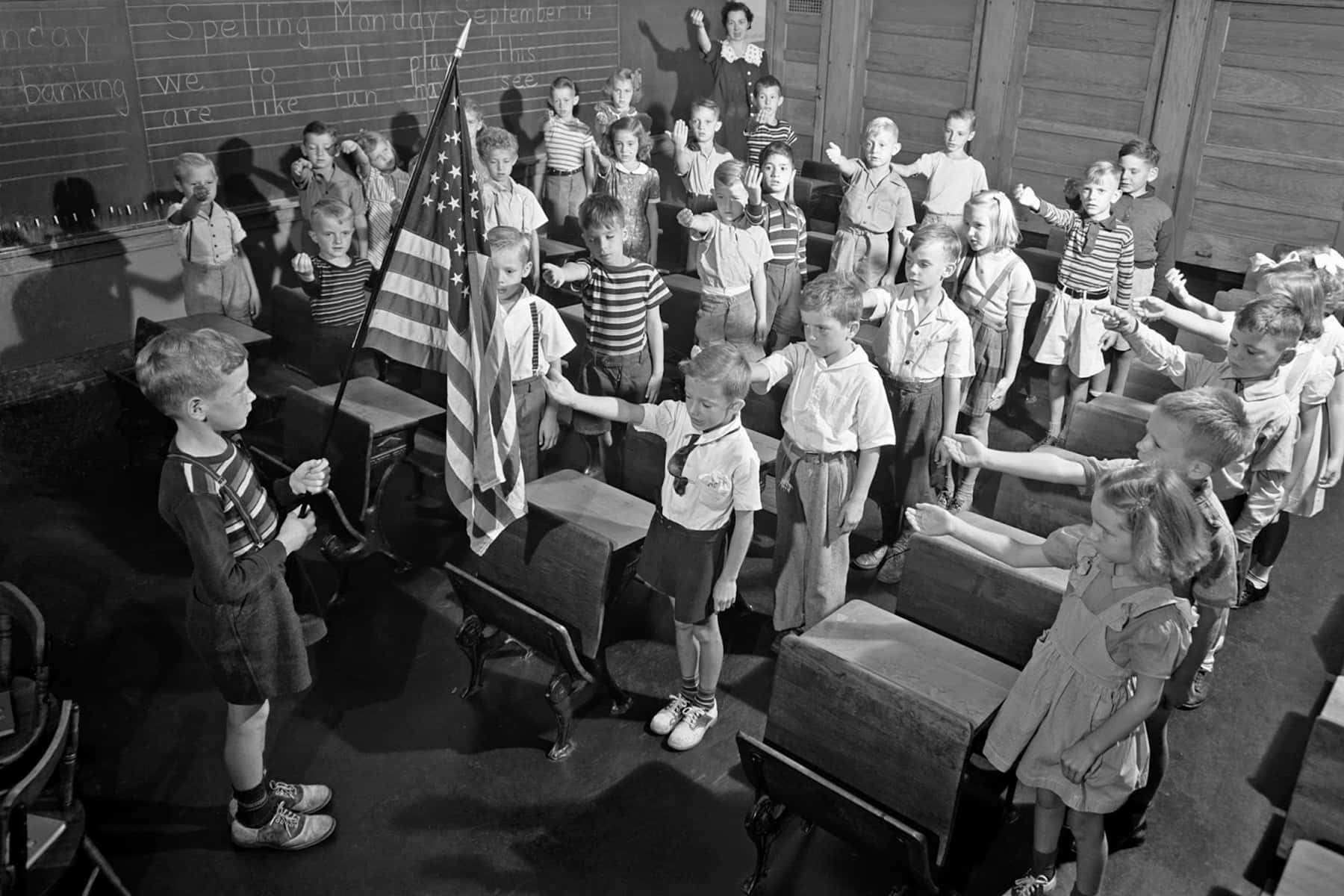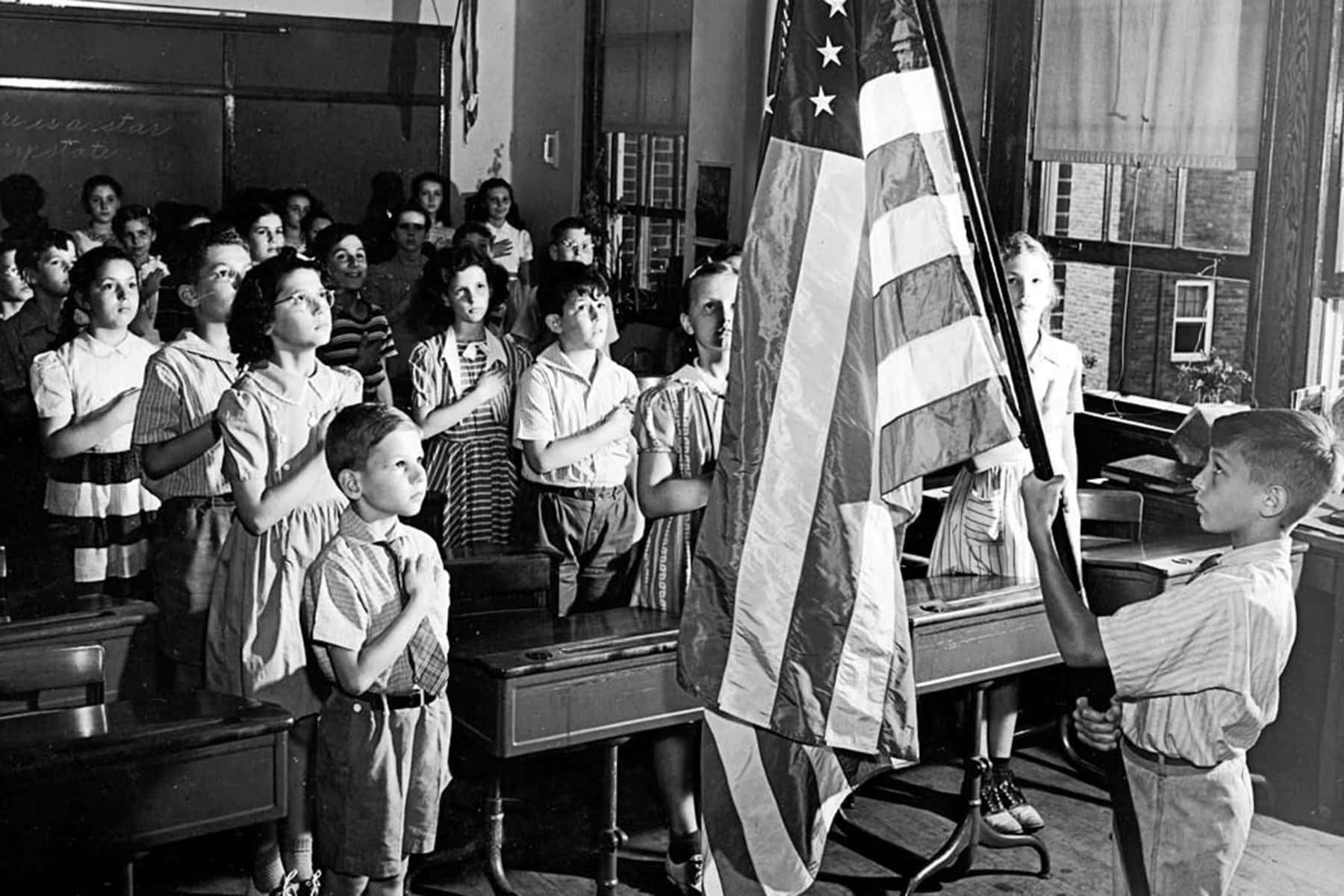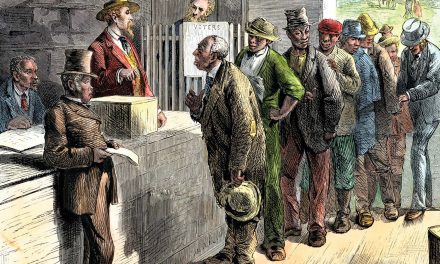
“Congress shall make no law respecting an establishment of religion, or prohibiting the free exercise thereof; or abridging the freedom of speech, or of the press; or the right of the people peaceably to assemble, and to petition the Government for a redress of grievances.” – First Amendment to the United States Constitution
A black sixth grade student was arrested in Florida after refusing to stand for the Pledge of Allegiance. The police arrested him for disruption and resisting arrest. The 11 year-old student at Lawton Chiles Middle Academy – in Lakeland, east of Tampa – refused to stand and recite the Pledge, prompting the substitute teacher to become upset.
On February 4, the student was in class when the Pledge of Allegiance was to be recited but refused, saying “that he won’t because the flag of this country was racist,” according to the statement from the teacher. “He then started to explain why the National Anthem was offensive to black people.”
According to a handwritten statement from the teacher, Ana Alvarez, she asked the student if living in the United States was “so bad” then why not go to another place to live?
The student replied, “They brought me here.”
“Well you can always go back, because I came here from Cuba, and the day I feel I am not welcome here anymore, I would find another place to live,” Alvarez replied, then called the office to have the student removed from the classroom.
“Suspend me! I don’t care. This school is racist,” the student told the dean as he walked out of the classroom with his backpack.
The student then allegedly “created another disturbance and made threats while he was escorted to the office.” He was later charged by police with disruption of a school facility and resisting an officer without violence by the Lakeland Police.
According to the arresting officer, Carlos Cortez, the student “continued to yell that the teacher had told him to, “Go back to Africa.” The student continued saying, “I’m not leaving. Do your job and take her, she’s the racist one who told me to go back to Africa.”
From reports in the Ledger, the local newspaper, Cortes also wrote in the police report that the student told the dean not to touch him and that he would call the police on him. After finally leaving the classroom, the student continued yelling in the hallway “You’re all racist.” When he entered the office he began crying and screamed, “I’m going to beat that teacher.”
Attorney Roderick Ford is representing the student’s family and said they are filing a lawsuit due to the treatment of the 11 year-old, because he was exercising his constitutionally protected right of free speech. They are filing a civil-rights complaint with the federal Department of Education.
“There is an improper constitutional deprivation of rights that goes to the heart of the founding of this country. He is very proud to be an American and he was acting in the greatest tradition of being an American,” said Ford.
Brian Haas, the state attorney for the 10th Judicial Circuit in Florida, said that his office would not press charges in the case. “The case is closed,” Haas said.
The American Civil Liberties Union (ACLU) called the encounter “outrageous.” The New York Times reported that “a lawyer for the boy’s family suggested that the case had not been resolved because the boy’s mother, Dhakira Talbot, declined an offer from prosecutors to drop the case if the boy completed a so-called diversion program, which could include a fine and community service.”
There is a lot to unpack in this situation, and color has an influence on the perception of what took place.
As a former teacher myself, I am upset that something which should have been a teachable moment turned into a traumatizing arrest and national media coverage. The student is now in another school, but continues to deal with the aftermath of this mess. His family has also been traumatized. The school refused to allow the student to call his mother during the incident when he asked them to. The school resource (police) officer was asked to handle things, when a phone call to his mom could have helped the student to calm down.
The substitute teacher will not be allowed to work at the school in the future. That alone is an indictment of the school. Clearly they believe the teacher instigated the incident, otherwise they would have no reason to not invite her back. For this adult to challenge a student and tell him to “Go Back to Africa” is highly problematic and clearly racist.
For those who choose to tell black people to “Go back to Africa” let me offer this: Compensate black people for the free labor of their ancestors who paid with their lives to build this country. Give black people reparations for that stolen labor. Give black people compensation for the four hundred years of pain and suffering. Give black people the proceeds of the wealth created by their ancestors toiling under the threat of a violent death. Go to Africa and fix all the damage Europe and America caused in their greed to find free labor, and the theft of that wealth from the continent. If all of those things could be accomplished, some black people might consider going back to the homeland they never had the chance to grow up in.
The initial response by Alvarez to the student, about her coming from Cuba and having the choice to go back if she did like America, is an example of how out of touch she is. It also shows the hierarchy of misunderstanding that exists regardless of ethnicity.
Alvarez is a Hispanic woman and immigrant, yet she not aware that black people were forcibly taken to America in shackles after being kidnapped in their homeland? Does she not know that thousands of Africans were enslaved in Cuba? Africans had no choice about being here. She chose to leave Cuba and come to America. Our ancestors did not.
The teacher talked about leaving if she found it unwelcoming to her. America has proven to be unwelcoming to black people for nearly four hundred years. And considering how the President of the United States has condemned and vilified Hispanic people, America does not appear to be very welcoming to anyone south of the border. Americans – even military veterans – have been detained simply for speaking Spanish.
Africa is certainly farther away than the 90-mile trip to Florida from Cuba. Practically speaking it is a little bit more difficult to just pack up and leave for a land across the ocean than most of us has never known.
Besides that, we have no way of knowing where we came from in Africa. Our families have been displaced, and dispersed without any information about our ancestral home. Even DNA tests that purportedly tell us where we are from only approximate based on who lives in those places today. Over the past four hundred years, the people of West Africa have had their ancestral homelands disrupted by European interlopers who “colonized” a majority of the continent, creating fake borders that had never existed before. Therefore, the people who live in those places now are not necessarily the people who have always lived in those places.
Controversies surrounding students refusing to stand and recite the pledge are not new. Last year Windfern High School senior India Landry, who is also black, was expelled from her school in Houston, Texas. Landry had sat during the pledge many times previously. Her mother stated that the principal told her that when she came to pick up her daughter, “She can’t come to my school if she won’t stand for the pledge.”
The mother reported that she was told by a school official: “This isn’t the NFL,” in reference to the protest by several NFL players including Colin Kaepernick. In 2017, two Texas high school football players were kicked off their team for protests, including one of them kneeling and the other holding up a fist during the national anthem. One of the students, Cedric “CJ” Ingram-Lewis told the Washington Post that the coach approached the two and “he told us to take off our uniform and leave it there.”
Landry said, “I don’t think that the flag is what it says it stands for, for liberty and justice and all that. It’s not obviously what’s going on in America today.”
She protested by sitting down at least 200 times over the year. What led to her expulsion was that she refused to stand for the pledge in the principal’s office on October 2, 2017. The assistant principal told Landry that she would have “to stand for the Pledge of Allegiance like other African-Americans in her class.”
Last September her family filed a lawsuit against Cypress Fairbanks Independent School District, saying her right to free speech and due process were violated by the expulsion. According to Texas law, students are required to stand for the pledge unless they have a parent or guardian’s permission to opt out.
“Schoolchildren cannot unilaterally refuse to participate in the pledge,” Texas Attorney General Ken Paxton said, according to a report in USA Today. He added that Texas is one of 26 states with similar Pledge statutes. Paxton is supporting a lawsuit which seeks to uphold the expulsion. “Requiring the pledge to be recited at the start of every school day has the laudable result of fostering respect for our flag and a patriotic love of our country.”
In a landmark 1943 case, West Virginia State Board of Education v. Barnette, the United States Supreme Court held that the Free Speech Clause of the First Amendment protects students from being forced to salute the American flag or say the Pledge of Allegiance in public school. The case was brought by a group of Jehovah’s Witnesses whose religion forbids them from saluting or pledging to symbols.
Law professor Brian Owsley of UNT Dallas College of Law, penned an article for the Dallas Morning News stating that:
“In Barnette, the education board adopted a resolution requiring schoolchildren to extend their right arms, palms upward, and recite the Pledge of Allegiance to the flag as well as the United States. A failure to salute the flag was deemed to be an act of insubordination resulting in the student being expelled from school. Moreover, their parents were subject to prosecution because the expelled children were deemed to be unlawfully absent from school in violation of state law. The Barnettes were Jehovah’s Witnesses whose faith barred them from swearing allegiance to the flag.”
The Supreme Court decision found that “if there is any fixed star in our constitutional constellation, it is that no official, high or petty, can prescribe what shall be orthodox in politics, nationalism, religion, or other matters of opinion or force citizens to confess by word or act their faith therein.”
From a legal standpoint, these students are within their rights to not stand for the pledge. To be expelled or arrested as a result of refusing is quintessentially American. Ignoring the U.S. Supreme Court decision in this case is reminiscent of the refusal of schools across the country to abide by the mandates of the landmark 1954 Supreme Court case Brown v. Board of Education, which demanded an end to forced segregation of public schools.
The racial elements in each of these cases cannot be ignored. A history of the Pledge of Allegiance provides some insights. Socialist minister Francis Bellamy wrote a pledge in August 1892, hoping it would be used in many countries.
“I pledge allegiance to my Flag and the Republic for which it stands, one nation, indivisible, with liberty and justice for all.”
A 1923 change added the words, “the Flag of the United States of America.” In 1954, President Eisenhower encouraged Congress to add the words “under God” to the pledge. They did so on June 14, 1954 leaving us with the current pledge:
“I pledge allegiance to the flag of the United States of America, and to the republic for which it stands, one nation under God, indivisible, with liberty and justice for all.”
The pledge was accompanied by a military style salute which came to be known as “The Bellamy Salute,” where the right hand was held over the heart. After reciting “to the Flag,” the arm was extended toward the Flag, palm-down. During WWII the salute resembled the Nazi salute too much and it was changed to just holding the hand over the heart during the entire pledge. In 1954 Joseph L. Lewis of New York brought a lawsuit that challenged the addition of the words “under God.” The Court dismissed the claims presented by Lewis, that the Pledge was an establishment of religion by stating:
“There cannot be the slightest doubt that the First Amendment reflect the philosophy that Church and State should be separated. The First Amendment, however, does not say that in every and all respects there shall be a separation of Church and State. Rather, it studiously defines the manner, the specific ways, in which there shall be no concert or union or dependency one on the other. That is the common sense of the matter. Otherwise the state and religion would be aliens to each other—hostile, suspicious, and even unfriendly. Prayers in our legislative halls; the appeals to the Almighty that run through our laws, our public rituals, our ceremonies would be flouting the First Amendment.”
The use of American flags in schools is an interesting story as well, and explains how a clever marketing individual led the nation into the recitation of the Pledge. Just a few short years before the pledge was written, Daniel Sharp Ford, owner of The Youth’s Companion, a children’s publication that focused on “virtue and piety,” launched a campaign to sell flags to American schools. It was part of a schoolhouse flag movement bandwagon he jumped on with hopes of increasing subscriptions to his publication.
Ford’s marketing director, James B. Upham, was asked to develop a marketing gimmick to get schools to purchase more flags. Upham decided to find a way to monetize patriotism by creating a “pledge” in which children would declare their love for the country. He hired Francis Bellamy to write something that could easily be recited in “15 seconds or less.” Bellamy wanted to include the words “equality” and “fraternity” in the pledge but his editors did not want to provide a precedent, which acknowledged the rights of blacks and women.
President Benjamin Harrison had urged the nation to celebrate the first ever-national Columbus Day in 1892, marking the 400th anniversary of the “discovery” of America. The President wanted teachers to emphasize the importance of teaching students about patriotism. Bellamy sold his idea at a national convention and designed the holiday celebration around an elaborate flag-raising ceremony, along with his pledge. Ford managed to sell American flags to nearly 30,000 U.S. schools, and the Pledge became a fixture in classrooms around the country.
Americans often focus too much on tradition without asking why, or understanding the origins of our customs. The inspiration for the Pledge had more to do with marketing and capitalistic calculations to make money than about national patriotism.
As our society ignores the opportunities to have constructive discussions about patriotism and race in America, we will continue to see more students harassed for expressing their First Amendment rights when they refuse to stand for the National Anthem or Pledge Allegiance to the American flag.
On June 14, 1777, the Continental Congress passed a resolution establishing an official flag for the country. It stated: “Resolved, that the flag of the United States be thirteen stripes, alternate red and white; that the union be thirteen stars, white in a blue field, representing a new constellation.” “Old Glory” would become the official flag of the new nation.
The flag that white America expects black people to pledge allegiance to would fly over the nation that enslaved millions of Africans for 88 years after the flag was created.
It would fly over the nation that promoted and permitted racial violence against blacks after slavery was “abolished” in 1865. The flag would fly over the nation, whose Supreme Court stated in Plessy V. Ferguson (1896) that segregation of the races is perfectly okay. This same flag flew over the nation that stood by and did nothing to stop the thousands of ritualistic murders of blacks – known as lynching – for decades. The flag flew over the nation that permitted major professional sports leagues to exclude black players for decades. These same leagues now force everyone to bear witness to the playing of the national anthem at every one of their games.
The Ku Klux Klan carried the U.S. flag as its patriotic symbol for many years before they adopted the Confederate Flag.
The stars and stripes of our flag means something different to those of us who choose to honor our ancestors, when this nation treated them inhumanly. Native Americans, who were the victims of genocide and the theft of their ancestral lands have a legitimate gripe with the American flag. Asians, who were denied entry to this country by laws such as the 1882 Chinese Exclusion Act have a legitimate argument with the American flag. Mexicans, who became a part of the United States when nearly half of their country was taken over at the end of the Mexican American War have a legitimate argument with the American flag.
Just because these populations to not make their arguments public does not mean they accept the situation. They have tried to be accepted by adapting to white American cultural expectations, because they would be punished otherwise – and provide another excuse for discrimination.
Is it possible to love the country and still protest against the flag and pledge? Absolutely. We can love our family and still have issues with them. Likewise, we can serve in the armed services and still disagree with our nation’s political policies. The Baby Boomer generation, who disrupted society and questioned conservative culture during the Vietnam War, is now the same generation that forbids questioning the government or sharing individual opinions. Rejecting the narrative about equal justice in America is not unpatriotic.
What is unpatriotic is not challenging your country to be better. What is unpatriotic is refusing to be honest about the marginalization of people of color. What is unpatriotic is not standing up for the rights granted to us by the U.S. Constitution, such as our freedom of speech. No one is entitled to tell others how they should express their displeasure with the nation they call home. No one can tell you how to express your patriotism unless they have walked in your shoes.
© Photo
Library of Congress















